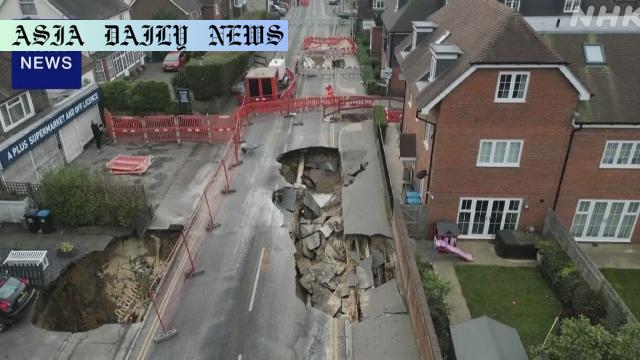Sinkhole: A huge sinkhole near London forces evacuation, uncovering a water pool and posing risks of gas pipe ruptures.
- Massive sinkhole appears in Surrey County, near London.
- Sinkhole expands to 20 meters, leading to 30 building evacuations.
- Concerns grow over potential gas pipe ruptures and explosions.
- Nearby stone quarry may be linked to the collapse, investigations ongoing.

A Massive Sinkhole Wreaks Havoc in Surrey County
Residents of a quiet residential area near London were left shocked and displaced after a massive sinkhole opened up in Surrey County this week. The incident unfolded on a seemingly ordinary Monday when part of a street collapsed suddenly, creating a gaping hole that now measures an estimated 20 meters in length. Remarkably, no injuries have been reported, a fact many residents have credited to the timing of the collapse.
Evacuations and Safety Concerns
The sudden appearance of the sinkhole has prompted the evacuation of around 30 buildings in the vicinity. Authorities expressed concerns that the ongoing collapse could damage nearby gas pipes, potentially causing an explosion. Emergency services acted swiftly to protect residents as engineers began assessing the site, ensuring no additional risks were posed to the public. One resident described the scene as surreal, adding how fortunate it was that no vehicles or pedestrians were present when the collapse occurred.
Exposure of Underground Infrastructure
As the sinkhole expanded, it exposed underlying infrastructure, including water pipes and stagnant pools of water beneath the street. These findings have raised questions about whether years of underground erosion or water accumulation contributed to the road’s instability. Such insights are invaluable to engineers and urban planners as they work to prevent similar incidents in the future.
Historical Context: A Stone Quarry’s Role?
The location’s history also plays a significant role in understanding the catastrophe. Reports indicate that the affected area was previously the site of a stone quarry. Over time, old mining sites can lead to unstable ground conditions, especially if they have not been adequately reinforced. Investigators are working diligently to determine whether this factor played a role in the current situation.
Media Comparisons and Widespread Attention
Unsurprisingly, the dramatic nature of the sinkhole and its implications have garnered significant media attention. British and international outlets have highlighted this event, comparing it to a similar incident that occurred in Yashio, Japan, last month. Such comparisons underscore the global risks posed by geological and infrastructural weaknesses in urban areas.
Coping and Moving Forward
For the displaced residents, the days ahead are likely to be challenging. Some families are currently housed in temporary accommodations as they await further updates. While this sinkhole has left the community shaken, it also serves as a sobering reminder of the need for continuous infrastructure evaluation, especially in areas with a history of geological instability.
The Bigger Picture: Urban Planning and Public Safety
This incident is not an isolated case. It brings into focus larger discussions about the fragility of urban infrastructure across the globe. With increasing urban populations and aging infrastructure, cities must prioritize the safety and security of their residents. Proactive measures, such as regular ground stability assessments and maintenance of underground systems, are crucial to preventing future tragedies.
In Closing
As investigations continue, the Surrey community, like so many others before it, must contend with the immediate realities of displacement and repair. It is hoped that this unfortunate event serves as a catalyst for meaningful change, ensuring that future sinkholes are identified and addressed before they turn into crises. Until then, the residents and local authorities will remain vigilant, navigating the challenges brought forth by this startling disaster.



Commentary
Understanding the Impact of the Sinkhole
The sudden appearance of a massive sinkhole in Surrey County near London is a stark reminder of the unexpected challenges that urban communities can face. For the residents of the affected area, it is not merely a hole in the ground but a direct disruption of their lives and a potential risk to their safety. While the absence of injuries is a relief, the extent of the damage and the ongoing risks, such as potential gas ruptures, rightly prompt concern.
A Historical and Structural Perspective
What makes this incident particularly intriguing is the possible link to a historical stone quarry. Such sites, once bustling hubs of activity, often become forgotten relics of a bygone era. However, their impact lingers, sometimes beneath the surface, as seen here. Engineering teams and local councils should take this opportunity to revisit how old industrial sites are monitored and managed, ensuring the safety of developing urban areas atop these historical footprints.
The Importance of Infrastructure Maintenance
From a broader perspective, this sinkhole highlights the importance of prioritizing infrastructure maintenance. Aging roads and underground systems are issues faced by countless cities around the world, suggesting that such events could become more frequent if attention and funding are not allocated. Urban planning cannot afford to take ground stability for granted, particularly in areas with known geological risks.
Reflections on Proactive Measures
Overall, while the Surrey sinkhole is undoubtedly a tragedy, it also provides an opportunity to reflect, learn, and improve. By investing in cutting-edge technologies for monitoring and reinforcing underground systems, authorities can prevent similar incidents. Moving forward, collaboration between geologists, engineers, and urban planners will be key to securing the foundation upon which our cities rest.